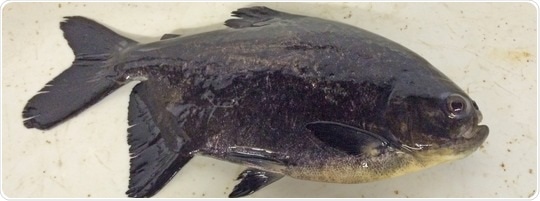Feb 19 2019
By studying fish raised in aquaculture, researchers from the Helmholtz Zentrum München, the University of Copenhagen and the University of Campinas in Brazil have shed new light on the mechanisms by which antibiotic resistance genes are transferred between bacteria. According to the study published in the journal ‘Microbiome’, those mechanisms are more varied than previously thought.

Piaractus mesopotamicus, a South American species known as pacu, is often raised in aquaculture. © Helmholtz Zentrum München
“In the past 70 years, the use of antibiotics in human and veterinary medicine has steadily increased, leading to a dramatic rise in resistant microorganisms,” says Prof. Dr. Michael Schloter, head of the Research Unit for Comparative Microbiome Analyses (COMI) at Helmholtz Zentrum München. It is especially alarming that many microorganisms are resistant not just to one antibiotic, but to a whole range of different substances, states the corresponding author of the recent study. This poses particular problems in the treatment of infectious diseases. “We therefore set out to discover the mechanisms responsible for resistance development,” he says.
To this end, he and his team, together with Danish scientists led by Gisle Vestergaard (University of Copenhagen and Helmholtz Zentrum München), investigated fish raised in aquaculture. Specifically, they studied Piaractus mesopotamicus, a South American species known as pacu that is often raised in aquaculture. The fish received the antibiotic florfenicol in their food for 34 days. During this time and after the application period, the researchers took samples from the digestive tract of the fish and looked for relevant genetic changes in the gut bacteria.
Resistance genes hop around the genome
As expected, administration of the antibiotic induced an increase in the genes responsible for resistance to that antibiotic. One example are genes for pump proteins, which simply remove the active substance from the bacteria again. However, we were particularly surprised by the different mechanisms that we could detect by which antibiotic resistance genes are spread amongst gut bacteria of the fish. This suggests that the bacteria also exchange resistance through viruses, known as phages, and transposons.”
Johan Sebastian Sáenz Medina, COMI Doctoral Student, Lead Author of the Paper
Further metagenomic studies confirmed that these mobile genetic elements induce a fast distribution of resistance genes among genomes of different organisms. So far it has been postulated that only plasmids (in essence, easily transferable mini-chromosomes) are mainly responsible for the exchange of resistance genes.
The finding that resistance is also extensively transferred between bacteria without the involvement of plasmids is really quite surprising. Based on this observation, relevant dissemination models should be reviewed and modified. In addition, our data certainly lead us to question whether and to what extent we should continue to use antibiotics in the world’s increasing number of aquacultures.”
Prof. Dr. Michael Schloter, Head of the Research Unit for Comparative Microbiome Analyses (COMI) at Helmholtz Zentrum München